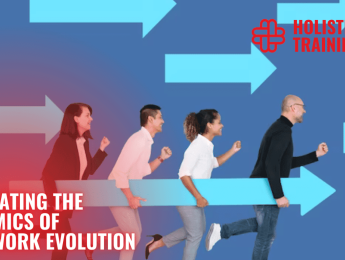- Table of Contents
- Introduction
- The Pillars of Teamwork
- 1. Communication
- 2. Trust
- 3. Roles and Responsibilities
- 4. Respect and Diversity
- What Causes Teamwork Evolution?
- 1. Technological Advancements
- 2. Evolving Work Culture
- 3. Globalisation
- 4. Complex Problem Solving
- Why Is Teamwork Evolution Important?
- Enhanced Creativity and Innovation
- Adaptability to Change
- Efficiency and Productivity
- Employee Satisfaction and Retention
- Competitive Advantage
- How Did Teamwork Evolve After COVID-19?
- Virtual Collaboration
- Flexible Work Arrangements
- Emotional Well-being
- Outcome-Oriented Approach
- Tips to Facilitate Teamwork Evolution
- 1. Invest in Communication Tools
- 2. Promote Psychological Safety
- 3. Continuous Learning
- 4. Regular Team Assessments
- 5. Celebrate Diversity
- 6. Acknowledge Achievements
- The Future of Teamwork
- Collaborative AI Assistants
- Augmented Decision-Making
- Redefining Roles and Skill Sets
- Ethical Considerations
- Training and Education
- Hybrid Workforces
- Enhanced Creativity and Innovation
- Monitoring and Governance
- Conclusion
Introduction
In the intricate tapestry of human progress, one thread remains constant and vital - teamwork. From the dawn of civilization to the digital age, the concept of teamwork has evolved, reshaping its contours in response to changing circumstances, technologies, and social dynamics. In this exploration, we delve into the fascinating phenomenon of teamwork evolution, uncovering its pillars, causes, significance, and its transformative journey post the COVID-19 pandemic. Join us as we navigate through the intricacies of teamwork's transformative journey and learn how to facilitate its evolution in the modern era.
The Pillars of Teamwork
Teamwork is a dynamic and intricate process that relies on a strong foundation built upon four essential pillars: Communication, Trust, Roles and Responsibilities, and Respect and Diversity. These pillars form the bedrock upon which successful teams are constructed. Let's delve deeper into each of these pillars to understand their significance in the evolution of teamwork.
1. Communication
Effective communication is the cornerstone of any thriving team. It goes beyond mere information exchange; it encompasses the art of conveying ideas, sharing knowledge, and providing feedback. In a rapidly evolving world, where information flows incessantly, the importance of seamless communication cannot be overstated.
In today's digital age,communication tools have evolved dramatically. From traditional face-to-face meetings and phone calls to instant messaging platforms and video conferencing, teams now have an array of options at their disposal. These tools have transcended geographical barriers, enabling teams to collaborate across time zones and continents seamlessly. Moreover, the rise of asynchronous communication allows team members to communicate at their convenience, fostering flexibility in work arrangements.
However, effective communication is not solely reliant on tools; it also demands active listening and empathy. Teams that actively listen to one another's ideas and concerns, provide constructive feedback, and create an environment where everyone's voice is heard, lay the foundation for innovative problem-solving and enhanced cohesion.
2. Trust
Trust is the invisible force that binds teams together. It is the confidence that each team member will contribute their best efforts and support one another. Without trust, even the most talented individuals cannot function effectively as a team.
Trust can be built over time through consistent actions and open communication. It's about delivering on promises, being transparent about challenges, and having each other's backs when the going gets tough. In a remote and distributed work environment, trust becomes even more crucial as team members may not have the opportunity for face-to-face interactions to establish trust naturally.
Team leaders play a pivotal role in fostering trust within their teams. They can lead by example, demonstrate vulnerability, and create a safe space for team members to share their thoughts and concerns. Trust is a fragile asset that, once shattered, can be challenging to rebuild. Therefore, nurturing trust should be an ongoing endeavour within any team.
3. Roles and Responsibilities
In the evolving landscape of teamwork, clarity in roles and responsibilities minimises confusion and enhances accountability. As teams tackle increasingly complex challenges, knowing who is responsible for what becomes paramount.
Teams should establish clear job descriptions and define individual roles within the larger team structure. This not only prevents overlap and duplication of efforts but also ensures that every team member understands their unique contribution to the collective goal. Modern project management tools, such as Trello and Asana, can assist in allocating tasks and tracking progress, further streamlining teamwork.
Moreover, the concept of role flexibility is gaining prominence. In dynamic work environments, team members may need to adapt to changing circumstances, taking on new responsibilities or shifting focus as needed. This adaptability is a reflection of a team's ability to evolve in response to challenges and opportunities.
4. Respect and Diversity
The final pillar, respect and diversity, recognises the value of different perspectives, experiences, and skills within a team. Diversity, whether in terms of cultural backgrounds, gender, age, or professional expertise, enriches the team's problem-solving capacity.
In an increasingly interconnected world, teams often comprise individuals from various corners of the globe. This global perspective brings forth new ideas, innovative approaches, and a deeper understanding of diverse markets and cultures. However, managing diversity effectively requires an emphasis on cross-cultural understanding and communication skills.
Respectful interactions are the cornerstone of harnessing diversity's potential. It's about valuing every team member's input, even when their viewpoints differ from your own. Respectful disagreements can lead to constructive debates and innovative solutions. Creating an inclusive environment where diversity is celebrated and all voices are encouraged is vital for fostering teamwork that thrives on differences.
In short, the four pillars of teamwork—Communication, Trust, Roles and Responsibilities, and Respect and Diversity—form an interdependent framework that underpins the success of any team. As teamwork continues to evolve in response to technological advances, shifting work cultures, and global connectivity, these pillars remain steadfast, guiding teams toward collaboration, innovation, and adaptability. Building upon these pillars and adapting them to the ever-changing landscape of the modern era is essential for teams to excel and thrive.
What Causes Teamwork Evolution?
Teamwork evolution is a dynamic process driven by a multitude of factors, responding to changes in technology, work culture, globalisation, and the complexity of modern challenges. Understanding the forces behind teamwork evolution is crucial to adapting and thriving in today's rapidly changing landscape.
1. Technological Advancements
Technological advancements have been a primary catalyst for the evolution of teamwork. The digital revolution, in particular, has fundamentally reshaped how teams collaborate and communicate. Here are some key aspects:
- Communication Tools:The advent of advanced communication tools like video conferencing, instant messaging apps, and collaborative software platforms has revolutionised the way teams interact. Video conferencing, for example, has made it possible for team members to see and hear each other in real-time, bridging the gap between remote and in-person collaboration.
- Cloud Computing: Cloud-based storage and collaboration platforms have allowed teams to access and work on documents, projects, and data from anywhere with an internet connection. This flexibility has enabled geographically dispersed teams to function seamlessly.
- Project Management Software: Tools like Trello, Asana, and Jira have streamlined project management, making it easier to assign tasks, track progress, and maintain transparency within teams.
- Automation and AI: The integration of automation and artificial intelligence in various industries has altered the nature of tasks and decision-making within teams. Routine tasks can now be automated, allowing team members to focus on more strategic and creative aspects of their work.
2. Evolving Work Culture
Work culture has evolved significantly, with a shift toward remote and flexible work arrangements. This transformation has had a profound impact on teamwork:
- Remote Work:The COVID-19 pandemic accelerated the adoption of remote work, making it a permanent feature of many organisations. Remote teams have had to adapt to new modes of communication and collaboration, emphasising the importance of digital tools and asynchronous work.
- Flexible Schedules: Teams now often operate on flexible schedules to accommodate diverse work-life needs. This flexibility promotes a work-life balance that can lead to increased productivity and job satisfaction.
3. Globalisation
Globalisation has turned the world into a closely interconnected global village. Teams frequently consist of individuals from diverse cultural backgrounds, which requires a heightened emphasis on cross-cultural understanding and communication skills. Here's how globalisation impacts teamwork:
- Diverse Perspectives:Global teams bring together a wealth of diverse perspectives, experiences, and skills. This diversity enhances problem-solving by providing a broader range of viewpoints and approaches.
- Cross-Cultural Collaboration:Teams must navigate cultural differences and communication challenges when working across borders. Effective cross-cultural collaboration involves cultural sensitivity and adaptability.
4. Complex Problem Solving
The challenges of the modern world are often intricate and multifaceted, demanding effective teamwork for holistic problem-solving. Here's why teamwork is essential in addressing complex challenges:
- Interdisciplinary Collaboration: Many contemporary issues require collaboration between experts from multiple fields. Teams must integrate knowledge and skills from diverse domains to find comprehensive solutions.
- Innovation and Adaptation:Rapid changes in technology and markets necessitate innovation and adaptability. Teams are often at the forefront of driving innovation within organisations.
- Global Issues:Global challenges such as climate change, public health crises, and economic instability require coordinated international efforts. Teams are crucial for addressing these global problems collectively.
In summary, teamwork evolution is driven by a combination of technological advancements, evolving work culture, globalisation, and the need to address increasingly complex challenges. Teams must adapt to these changes by leveraging digital tools, embracing flexible work arrangements, fostering cross-cultural collaboration, and enhancing their problem-solving abilities. Recognising the causes of teamwork evolution is the first step toward preparing for the future of work in the modern era.
Why Is Teamwork Evolution Important?
Teamwork evolution is not merely a trend; it is a fundamental necessity in the modern world. It holds profound significance for organisations and society as a whole, driving progress and innovation. Let's explore in greater detail why the evolution of teamwork is crucial:
Enhanced Creativity and Innovation
In today's highly competitive and rapidly changing business landscape, creativity and innovation are essential for staying ahead. Evolved teamwork is a catalyst for creativity and innovation in the following ways:
- Diverse Perspectives: Teams comprising members with diverse backgrounds, experiences, and skills bring a rich tapestry of ideas to the table. This diversity sparks creativity by introducing new viewpoints and approaches to problem-solving.
- Collaborative Brainstorming:Evolved teams encourage collaborative brainstorming sessions where team members can freely share and build upon each other's ideas. This synergy often leads to ingenious solutions and novel concepts.
- Cross-Pollination of Ideas:Evolved teamwork encourages the cross-pollination of ideas between team members who may have expertise in different areas. This interdisciplinary approach can result in groundbreaking innovations that wouldn't be possible with isolated efforts.
Adaptability to Change
In a world characterised by constant change and uncertainty, teams that can evolve and adapt are the ones that thrive. Here's why adaptability is vital:
- Flexibility in Strategy: Teams that evolve are more open to changing their strategies and approaches when circumstances demand it. They can pivot quickly in response to market shifts, technological advancements, or unexpected challenges.
- Resilience: Evolved teams are resilient in the face of adversity. They can weather storms and bounce back from setbacks by adjusting their tactics and learning from their experiences.
- Continuous Improvement: Teams that embrace evolution are committed to continuous improvement. They proactively seek out better ways of working, refine their processes, and stay relevant in their respective industries.
Efficiency and Productivity
Efficiency and productivity are paramount in today's fast-paced world. Evolved teamwork optimises resource allocation and task distribution:
- Resource Optimisation: Evolved teams are skilled at allocating resources effectively. Tasks are assigned to team members based on their strengths and expertise, ensuring that the right person is handling each task.
- Task Distribution: Team members understand their roles and responsibilities clearly, reducing overlap and preventing bottlenecks. This streamlined task distribution enhances efficiency and productivity.
- Time Management: Evolved teams are adept at managing their time and priorities efficiently. They use tools and techniques to minimise time wasted on administrative tasks and focus on high-value activities.
Employee Satisfaction and Retention
A positive work environment and a sense of personal growth within the team are crucial factors in employee satisfaction and retention. Evolved teams promote these qualities:
- Recognition and Valuation: In teams that evolve, individual contributions are recognised and valued. When team members feel appreciated for their efforts, they are more likely to stay committed to the team and the organisation.
- Opportunities for Growth:Evolved teams provide opportunities for personal and professional growth. Team members are encouraged to learn new skills, take on challenging projects, and advance in their careers within the team structure.
- Work-Life Balance:Evolved teams often promote a healthy work-life balance. This balance contributes to overall job satisfaction and reduces burnout, leading to greater employee retention.
Competitive Advantage
In a competitive business landscape, organisations that embrace teamwork evolution gain a competitive advantage. Here's how:
- Innovative Solutions: Evolved teams are more likely to develop innovative solutions that set their organisation apart from competitors.
- Agility:Organisations with evolved teams are more agile and responsive to changes in the market, giving them an edge in adapting to customer needs and preferences.
- Talent Attraction: Organisations that prioritise evolved teamwork tend to attract top talent. Prospective employees are drawn to organisations that foster a culture of collaboration, creativity, and growth.
How Did Teamwork Evolve After COVID-19?
The seismic shock of the COVID-19 pandemic reverberated through every aspect of our lives, including teamwork. As traditional workspaces shuttered, teamwork evolved to adapt to the "new normal":
Virtual Collaboration
Remote work became the norm, propelling virtual collaboration tools to the forefront. Video conferencing, project management software, and virtual whiteboards bridged the physical gap, enabling teams to continue their operations seamlessly. The pandemic accelerated the adoption of these technologies, making them integral to modern teamwork.
Table 1: Popular Virtual Collaboration Tools
Tool | Description |
Zoom | Video conferencing platform for meetings and webinars |
Slack | Messaging and collaboration platform |
Microsoft Teams | Unified communication and collaboration platform |
Trello | Visual project management tool |
Miro | Online collaborative whiteboard |
Flexible Work Arrangements
The pandemic emphasised the need for flexibility. Teamwork evolved to accommodate staggered work hours and new family-centric responsibilities, acknowledging that productivity thrives in adaptable environments. The traditional 9-to-5 workday became a relic as teams embraced flexible schedules that suited individual needs and lifestyles.
Emotional Well-being
The crisis highlighted the importance of empathy and emotional support within teams. Virtual check-ins and open discussions about mental health fostered stronger bonds, helping team members weather the storm together. Teams began prioritising the emotional well-being of their members, recognising that a healthy workforce is a productive one.
Outcome-Oriented Approach
With external uncertainties at an all-time high, teams shifted their focus from micromanagement to outcome-oriented strategies. Trusting team members to deliver results, irrespective of their physical location, became paramount. The pandemic forced teams to focus on what truly matters - achieving goals and delivering value to their organisations.
Table 2: Teamwork pre- and post-COVID-19
Tips to Facilitate Teamwork Evolution
Facilitating teamwork evolution requires proactive efforts and a commitment to continuous improvement. Here are some actionable tips to further enhance your team's evolution:
1. Invest in Communication Tools
Equipping your team with state-of-the-art communication tools is crucial for seamless interaction in the digital age. In addition to regular video meetings and chat platforms, consider integrating collaborative document sharing and project management tools. These tools not only enhance connectivity but also streamline workflow and data sharing.
Furthermore, provide training and resources to ensure that your team is proficient in using these tools effectively. Encourage team members to explore advanced features and integrations that can further optimise communication.
2. Promote Psychological Safety
Foster an environment where team members feel safe sharing their ideas and concerns without fear of judgement. In addition to open communication, emphasise psychological safety as a core value. This can be achieved through team-building exercises, trust-building workshops, and regular feedback sessions.
Leaders play a crucial role in promoting psychological safety by leading with vulnerability and empathy. When team leaders model open communication and demonstrate that it's safe to make mistakes and learn from them, team members are more likely to follow suit.
3. Continuous Learning
Encourage team members to acquire new skills and knowledge continuously. Invest in training and development programmes that align with the team's goals and objectives. Provide opportunities for cross-training, allowing team members to diversify their skill sets.
Consider setting aside time for regular knowledge-sharing sessions where team members can teach each other new skills or share insights gained from training. This not only enriches individual growth but also injects fresh perspectives into the team.
4. Regular Team Assessments
Periodically evaluating the team's dynamics is essential for identifying areas of improvement. Conduct regular retrospectives or assessments to gather feedback from team members about what is working well and where there are bottlenecks or communication gaps.
Once issues are identified, address them promptly. Adjust roles and strategies as needed to enhance team effectiveness. This flexibility ensures that the team can adapt to changing circumstances and continue evolving.
5. Celebrate Diversity
Embrace the diversity within your team as a strength. Actively seek out different viewpoints and approaches, encouraging a richer problem-solving process. Create opportunities for team members to share their cultural backgrounds, experiences, and perspectives.
Consider organising cultural exchange events, diversity training, or cross-functional projects that bring team members from different backgrounds together. These initiatives foster a greater appreciation for diversity and build strong cross-cultural bonds within the team.
6. Acknowledge Achievements
Celebrating both small victories and significant milestones is vital for team morale and motivation. Recognise and reward outstanding contributions regularly, and make it a point to acknowledge the efforts of every team member.
Publicly share success stories and case studies that highlight the team's achievements. This not only boosts morale but also reinforces the team's sense of purpose and the value of their collaboration.
The Future of Teamwork
The future of teamwork is intrinsically linked to the rapid advancements in artificial intelligence (AI) and automation. These technologies are transforming how teams operate, offering new possibilities, but also presenting unique challenges. Let's delve deeper into this intriguing aspect of teamwork evolution:
Collaborative AI Assistants
AI-powered virtual assistants are becoming integral members of teams, enhancing productivity and streamlining administrative tasks. These assistants can schedule meetings, answer routine inquiries, and even analyse data to provide valuable insights. However, the future of teamwork lies in how effectively teams integrate and collaborate with these AI entities.
Teams will need to adapt to working alongside AI, setting clear boundaries for their roles and responsibilities. Ensuring that AI assists rather than replaces human input is essential. Collaboration between team members and AI can result in more efficient decision-making and task execution.
Augmented Decision-Making
AI and automation are empowering teams with data-driven insights and predictive analytics. These tools can analyse vast datasets and offer recommendations for better decision-making. In the future, teams will rely on AI to augment their ability to make informed choices and strategic plans.
However, this evolution requires teams to be data-literate and capable of interpreting AI-generated insights. Training team members to understand AI-driven recommendations and incorporating these insights into their decision-making processes will be pivotal.
Redefining Roles and Skill Sets
As automation takes over routine tasks, teams will need to redefine their roles and skill sets. Job descriptions will evolve, with greater emphasis on skills such as data analysis, critical thinking, problem-solving, and creativity. Team members will need to be adaptable and open to acquiring new skills to remain relevant.
Furthermore, cross-disciplinary teams that include both human and AI members will become commonplace. Teams will need to learn how to effectively coordinate and leverage the strengths of both to achieve their objectives.
Ethical Considerations
The integration of AI and automation into teamwork raises ethical questions that must be addressed. Teams will need to grapple with issues related to data privacy, bias in algorithms, and the impact of automation on employment. Ethical frameworks and guidelines will be crucial in ensuring that AI and automation are used responsibly and ethically within teams.
Teams will also need to consider the societal implications of their work, particularly when developing AI-powered products or services. Ethical decision-making and responsible AI practices will become integral components of teamwork.
Training and Education
Preparing teams for the future of AI and automation in teamwork requires ongoing training and education. Organisations will need to invest in programmes that equip team members with the skills necessary to collaborate effectively with AI. This includes data literacy, AI ethics, and understanding the limitations and capabilities of AI systems.
Additionally, continuous learning and upskilling will be essential as AI and automation technologies continue to evolve. Teams must be agile in adapting to new tools and approaches.
Hybrid Workforces
The future of teamwork may involve hybrid workforces comprising humans and robots working side by side. In sectors like manufacturing, robotics is already playing a significant role in assembly lines. As these technologies advance, teams will need to navigate the integration of human and robotic labour, focusing on safety, efficiency, and collaboration.
Enhanced Creativity and Innovation
AI can be a powerful catalyst for creativity and innovation within teams. Machine learning algorithms can analyse vast datasets and generate creative solutions to complex problems. Teams will need to explore how AI can assist in the ideation and innovation processes, pushing the boundaries of what's possible.
Monitoring and Governance
Teams will need to establish monitoring and governance mechanisms for AI and automation systems. Regular audits and evaluations of AI's performance and impact will be necessary to ensure that it aligns with the team's goals and values. This oversight will also help teams identify areas for improvement and adjustment.
In short, the future of teamwork is deeply intertwined with AI and automation. Embracing these technologies and learning how to collaborate effectively with them will be essential for teams to thrive in a rapidly evolving work landscape. Teams must prepare for a future where AI and automation are not just tools but integral members of the team, augmenting human capabilities and pushing the boundaries of what's achievable.
Conclusion
The evolution of teamwork is an ever-unfolding saga, intricately woven into the fabric of human progress. The pillars of communication, trust, roles, and respect provide the foundation upon which teams navigate the changing landscapes of technology, culture, and global interconnectedness. As we emerge from the crucible of the COVID-19 pandemic, teamwork's evolution has been thrust into the spotlight, exemplifying its resilience and adaptability.
If you're looking to stay at the forefront of this evolution and become a leader in the digital era, make sure to enrol in our course, ‘Technological Leadership for the Digital Era.’ This course will equip you with the knowledge and skills needed to navigate the evolving landscape of teamwork in the modern world, harnessing the potential of technology, and leading your team towards a brighter and more innovative future. Join us in shaping the future of teamwork and technological leadership!

























